It looks like you're using an Ad Blocker.
Please white-list or disable AboveTopSecret.com in your ad-blocking tool.
Thank you.
Some features of ATS will be disabled while you continue to use an ad-blocker.
share:
Here may very well be the oldest know example of a Thracian Style Dragon/Welsh in Britain.

A coin of Tasciovonus.
Tasciovonus
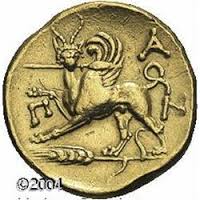
Thrace, City of Pantikapaion
This founding by the Milesians and the Thracian connection point directly to the same line of Celts that founded the Irish Royals at Donegal or Dan of the Gauls, judge of the Gauls being very related to some of the British tribes and kings.
Pantikapaion Thrace

A coin of Tasciovonus.
Tasciovonus

Thrace, City of Pantikapaion
In the 5th–4th centuries BC, the city became the residence first of the Archaeanactids and then of the Spartocids, dynasties of Thracian kings of Bosporus, and was hence itself sometimes called Bosporus. Its economic decline in the 4th–3rd centuries BC was the result of the Sarmatian conquest of the steppes and the growing competition of Egyptian grain.
Panticapaeum (Ancient Greek: Παντικάπαιον Pantikápaion) was an ancient Greek city on the eastern shore of Crimea, which the Greeks called Taurica. The city was built on Mount Mithridat, a hill on the western side of the Cimmerian Bosporus. It was founded by Milesians in the late 7th or early 6th century BC. The ruins of the site are now located in the modern city Kerch.
This founding by the Milesians and the Thracian connection point directly to the same line of Celts that founded the Irish Royals at Donegal or Dan of the Gauls, judge of the Gauls being very related to some of the British tribes and kings.
Pantikapaion Thrace
edit on 2-5-2014 by Logarock because: n
a reply to: Logarock
That looks incredibly like a carnyx to me. That's some amazing work you did on that stone, I have to say.
You know, the Irish always get the credit for Ogham - and yet it's on at least three pict stones that I can think of. I'll need to go and look properly. It would make sense if it were an ancient alphabet brought over from the Celts.
I was reading earlier about the similarities between Gaelic and Hebrew, from a researcher many moons ago. Quite an interesting read:
The Affinity Between...
That looks incredibly like a carnyx to me. That's some amazing work you did on that stone, I have to say.
You know, the Irish always get the credit for Ogham - and yet it's on at least three pict stones that I can think of. I'll need to go and look properly. It would make sense if it were an ancient alphabet brought over from the Celts.
I was reading earlier about the similarities between Gaelic and Hebrew, from a researcher many moons ago. Quite an interesting read:
The Affinity Between...
The earliest known date for copies of Philip's stater in Britain is 125 BC. As their experience of minting grew the Celts' designs became more original. As befitting a pastoral people the horse was a common feature.
Celtic Greek Conection in Britain before Rome

British Coin in Greek, Macedonian Style.
The Great Celtic Philosophers of Greece.
The Milesian school was a school of thought founded in the 6th century BC. The ideas associated with it are exemplified by three philosophers from the Ionian town of Miletus, on the Aegean coast of Anatolia: Thales, Anaximander, and Anaximenes. They introduced new opinions contrary to the prevailing viewpoint on how the world was organized, in which natural phenomena were explained solely by the will of anthropomorphized gods. The Milesians presented a view of nature in terms of methodologically observable entities, and as such was one of the first truly scientific philosophies.
The Milesian School
a reply to: Logarock
We are, you know.
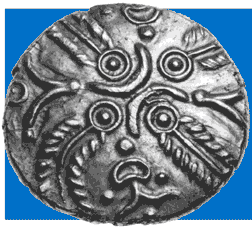
This is similar to the coin I was thinking about earlier, and you can see how the corn/wheat is blending in with the crescent. I didn't know the Celts hid faces in their coins, and I certainly never learned we were minting coins so early on. That's a good site you found.
Milesians? That's a coincidence. I'll explain, but I need to go for a bit. Back soon
We are, you know.

This is similar to the coin I was thinking about earlier, and you can see how the corn/wheat is blending in with the crescent. I didn't know the Celts hid faces in their coins, and I certainly never learned we were minting coins so early on. That's a good site you found.
Milesians? That's a coincidence. I'll explain, but I need to go for a bit. Back soon
a reply to: beansidhe
I think we have this nailed.
I am assuming that the above Thracian coin got you thinking about the wheat.
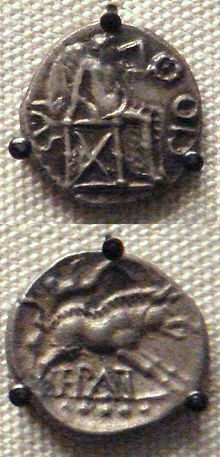
Just tossing this in here. This is a British coin of Tasciovonus. His icon there is the bore. Could it be that the bores being shot with arrows ect on the Pict stones could represent war with this guy?
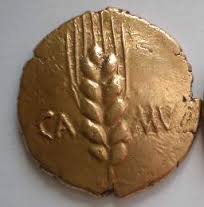
Above is a British coin of Catuvellius. Britain was certainly an agricultural power anyway. Anyway Thracian coins are covered with these wheat heads. Apparently wheat being shipped to Egypt at on time was so valuable a trade that they had wars over it there in the plains.
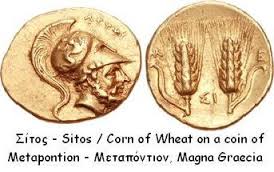
A Macedonian coin.
I think we have this nailed.
I am assuming that the above Thracian coin got you thinking about the wheat.

Just tossing this in here. This is a British coin of Tasciovonus. His icon there is the bore. Could it be that the bores being shot with arrows ect on the Pict stones could represent war with this guy?

Above is a British coin of Catuvellius. Britain was certainly an agricultural power anyway. Anyway Thracian coins are covered with these wheat heads. Apparently wheat being shipped to Egypt at on time was so valuable a trade that they had wars over it there in the plains.

A Macedonian coin.
edit on 2-5-2014 by Logarock because: n
Even the names of some of these British tribes and kings sound Greek with the "us/as" suffix.
Leonidas. -Greek
Tasciovonus, Epaticcus, Cumbelinus.....British.
And this Brits had no writing before Rome deal. Then what is all this writing on these coins? Time to really dig into Wilson for me.
Leonidas. -Greek
Tasciovonus, Epaticcus, Cumbelinus.....British.
And this Brits had no writing before Rome deal. Then what is all this writing on these coins? Time to really dig into Wilson for me.
a reply to: beansidhe
There very many stones in Wales with ogham on them, I have a book full of them. Some have ogham and latin, if my theory is right that the stones of wales were reused by the romans, then they had a written language before the romans came here.
You know, the Irish always get the credit for Ogham - and yet it's on at least three pict stones that I can think of
There very many stones in Wales with ogham on them, I have a book full of them. Some have ogham and latin, if my theory is right that the stones of wales were reused by the romans, then they had a written language before the romans came here.
originally posted by: Logarock
Even the names of some of these British tribes and kings sound Greek with the "us/as" suffix.
Leonidas. -Greek
Tasciovonus, Epaticcus, Cumbelinus.....British.
And this Brits had no writing before Rome deal. Then what is all this writing on these coins? Time to really dig into Wilson for me.
They have latin names as they are the names given to them by the romans, there are other names for them. For instance Cunobeline or Cunobelin is called Cynfelyn in the Welsh manuscripts.
originally posted by: Logarock
a reply to: beansidhe
Above is a British coin of Catuvellius. Britain was certainly an agricultural power anyway. Anyway Thracian coins are covered with these wheat heads. Apparently wheat being shipped to Egypt at on time was so valuable a trade that they had wars over it there in the plains.
That coin is a coin of Cunobeline. He is the basis for Shakespeare's Cymbeline.
edit on 2-5-2014 by urbanghost because: (no reason
given)
a reply to: urbanghost
Sorry about that. They have this coin listed under the Catuvellauni tribe and under Cunobelines father and brother Epaticcus. In fact its hard to follow all the contradictory information on line as you may know. But it is a Catuvellauni coin.
By they way join in on some of the days postings. There is a good deal of information to be dealt with.
Sorry about that. They have this coin listed under the Catuvellauni tribe and under Cunobelines father and brother Epaticcus. In fact its hard to follow all the contradictory information on line as you may know. But it is a Catuvellauni coin.
By they way join in on some of the days postings. There is a good deal of information to be dealt with.
a reply to: Logarock
Tasciovanus was around 20BC and he could easily have been the one the boar represents. He might also be the origins of the Twyrch stories too.
Yes it was the Thracian wheat coins that caught my eye
Just tossing this in here. This is a British coin of Tasciovonus. His icon there is the bore. Could it be that the bores being shot with arrows ect on the Pict stones could represent war with this guy?
Tasciovanus was around 20BC and he could easily have been the one the boar represents. He might also be the origins of the Twyrch stories too.
Yes it was the Thracian wheat coins that caught my eye
a reply to: urbanghost
Here is another Tasciovanus coin. Is a bit clearer than the example above.
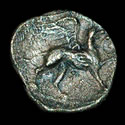
15 to 10 BC.
Some of the history around this time - 40 some years look like Roman efforts to install favorable regimes after Julius César. Maybe an attempt was made to take Celts from already subjugated areas, which Trace had just become relatively speaking, of the Empire and install them in Britain.
The Scordisci of Thrace; The Horror of Rome. 150 Years of Hell
This was the same policy they attempted early with the British Celts and around the same time.
A Roman "CIA" destabilization project.
Here is another Tasciovanus coin. Is a bit clearer than the example above.

15 to 10 BC.
Some of the history around this time - 40 some years look like Roman efforts to install favorable regimes after Julius César. Maybe an attempt was made to take Celts from already subjugated areas, which Trace had just become relatively speaking, of the Empire and install them in Britain.
The Scordisci of Thrace; The Horror of Rome. 150 Years of Hell
Text Crassus’ campaign of 29 BC and a subsequent one the following year in which he ‘punished’ the Scordisci tribes of northwestern Bulgaria (the Serdi, Meldi and Artacoi) (Dio Cass. 51. 26-27), marked a watershed in the history of Thrace. Soon afterwards a Thracian puppet government, drawn from members of the Odrysae tribe who had collaborated with Rome (loc cit), was installed to preside over the Romanization of Thrace. This so-called Sapaioi dynasty had little or no popular support in Thrace and Roman armies had to repeatedly intervene to save the new Thracian ‘kings’ from their own people (On the Odrysae Sapaioi dynasty see also ‘The Thracian Puppet Kings’ and ‘Behind the Golden Mask’ article).
This was the same policy they attempted early with the British Celts and around the same time.
For over 100 years the unity of the Balkan peoples – Thracians, Celts, Dardanii and Bastarnae – had held back the tide of Roman expansion in southeastern Europe. In the mid 1st c. BC this unity was torn asunder by the greed and ambition of one of these tribes, who unleashed an orgy of violence and destruction on its neighbors which would create the conditions for final conquest that Rome herself had failed to achieve.
A Roman "CIA" destabilization project.
originally posted by: urbanghost
a reply to: Logarock
Celtic Greek Conection in Britain before Rome
In the legends the Druids were supposed to be able to speak Latin, Greek and many other languages. Caesar wrote that they used Greek letters.
Yes I can understand that considering the Druids moved about and were educated. Celts were in Rome before it ever got great and lived in Italy. Druids were probably present at all negotiations so had to know Latin.
originally posted by: urbanghost
originally posted by: Logarock
Even the names of some of these British tribes and kings sound Greek with the "us/as" suffix.
Leonidas. -Greek
Tasciovonus, Epaticcus, Cumbelinus.....British.
And this Brits had no writing before Rome deal. Then what is all this writing on these coins? Time to really dig into Wilson for me.
They have latin names as they are the names given to them by the romans, there are other names for them. For instance Cunobeline or Cunobelin is called Cynfelyn in the Welsh manuscripts.
It could be, just a thought, that these were there names and the Welsh just translated them into their own language the best they could. I am just postulating that based on my idea about transplants from other parts of the Empire who understood how things were done on both sides. For instance it looks rather clear to me that Cunobline and his dad were puppets. Just a thought yet.
originally posted by: beansidhe
a reply to: Logarock
Just tossing this in here. This is a British coin of Tasciovonus. His icon there is the bore. Could it be that the bores being shot with arrows ect on the Pict stones could represent war with this guy?
Tasciovanus was around 20BC and he could easily have been the one the boar represents. He might also be the origins of the Twyrch stories too.
Yes it was the Thracian wheat coins that caught my eye
Isnt there a Pict stone of dogs tearing at a bore?
a reply to: Logarock
It could be, but if you look the name up it comes from the Latin Cunobelinus, derived from the Greek Kynobellinus. This points to it being a name given to him by the romans. There is evidence that he got on well with the romans and took on their ways and language and Romanised his name. He even copied their coins and called himself Rex, which is a roman title. The coins found have latin writing on them. The oldest mention of him that is not roman calls him Cinbelin, this is in the Harleian manuscripts.
It could be, just a thought, that these were there names and the Welsh just translated them into their own language the best they could.
It could be, but if you look the name up it comes from the Latin Cunobelinus, derived from the Greek Kynobellinus. This points to it being a name given to him by the romans. There is evidence that he got on well with the romans and took on their ways and language and Romanised his name. He even copied their coins and called himself Rex, which is a roman title. The coins found have latin writing on them. The oldest mention of him that is not roman calls him Cinbelin, this is in the Harleian manuscripts.
a reply to: urbanghost
So they were puppets! There is a chance they could have been Roman, Italian Celts. Celts in Greece as well.
So they were puppets! There is a chance they could have been Roman, Italian Celts. Celts in Greece as well.
new topics
-
This is adorable you guys!
General Chit Chat: 6 hours ago -
Reprehensible Behavior
US Political Madness: 7 hours ago -
Defending the need for adherence to Old Testament commandments under the new covenant of Christ
Conspiracies in Religions: 8 hours ago
top topics
-
Reprehensible Behavior
US Political Madness: 7 hours ago, 10 flags -
Those Drones over NJ and elsewhere
Aliens and UFOs: 12 hours ago, 8 flags -
South Korean coup was an attempt to start WW3
World War Three: 12 hours ago, 7 flags -
This is adorable you guys!
General Chit Chat: 6 hours ago, 7 flags -
Archer aviation and the NJ drones
Aircraft Projects: 13 hours ago, 5 flags -
Defending the need for adherence to Old Testament commandments under the new covenant of Christ
Conspiracies in Religions: 8 hours ago, 5 flags
active topics
-
Drones everywhere in New Jersey ---and Elsewhere Master Thread
Aliens and UFOs • 171 • : nugget1 -
Post A Funny (T&C Friendly) Pic Part IV: The LOL awakens!
General Chit Chat • 7912 • : imitator -
This is adorable you guys!
General Chit Chat • 4 • : CriticalStinker -
The Acronym Game .. Pt.4
General Chit Chat • 1016 • : FullHeathen -
Could rampant land speculation have caused the Civil War?
History • 35 • : matafuchs -
George Stephanopoulos and ABC agree to pay $15 million to settle Trump defamation suit
Mainstream News • 23 • : Brotherman -
Pelosi injured in Luxembourg
Other Current Events • 45 • : rickymouse -
Nov 2024 - Former President Barack Hussein Obama Has Lost His Aura.
US Political Madness • 19 • : Connector -
Sky Intruders - Drones, Deception & One Weird UFO Video : Weaponizes : Episode #62
Aliens and UFOs • 7 • : DontTreadOnMe -
They Know
Aliens and UFOs • 97 • : DontTreadOnMe
